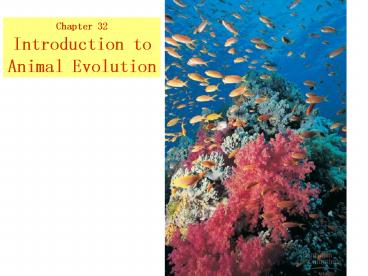Introduction to - PowerPoint PPT Presentation
1 / 34
Title:
Introduction to
Description:
Chapter 32 Introduction to Animal Evolution 26.16 Our changing view of biological diversity 26.1 Some major episodes in the history of life. Note that molecular ... – PowerPoint PPT presentation
Number of Views:174
Avg rating:3.0/5.0
Title: Introduction to
1
Chapter 32 Introduction to Animal Evolution
2
26.16 Our changing view of biological diversity
3
26.1 Some major episodes in the history of
life.Note that molecular evidence puts origin
of animals at 1 bya.
4
26.2 Clock analogy for some key events in
evolutionary history
5
32.4 A traditional view of animal diversity
based on body-plan grades
6
Kingdom Animalia general characteristics (and
yes, there are exceptions)
- Multicellular, heterotrophic eukaryotes.
- Feed by ingestion.
- Lack cell walls. Bodies held together by
structural proteins embedded in tissues
(collagen) and between cells. - Presence of nervous and muscle tissue
- Store carbohydrate reserves as glycogen
- Reproduce sexually with characteristic
development of the early 2N embryo. - Transformation and development of the zygote
controlled by special regulatory genes (Hox
genes).
7
I. What is an animal? A. Structure, nutrition,
and life history define animals 1. Animals are
multicellular, heterotrophic eukaryotes.
- Animals must take
in organic molecules by ingestion they eat other
organisms or organic material that is
decomposing. 2. Animal cells have no cell
walls. - Bodies are held together by proteins,
especially collagen. 3. Animals have two
unique types of tissues
a. Nervous tissue and
b. Muscle tissue
8
4. Most animals reproduce sexually.
a. Dominant stage is
typically diploid. b. Motile sperm fertilizes a
larger, non-motile egg (both 1n). c. The
resulting zygote (2n) goes through embryonic
development as follows i. The zygote
undergoes cleavage, a series of mitotic cell
divisions. ii. Cleavage results in the
formation of a blastula, a hollow ball of
cells. iii. Further development results
in the formation of a gastrula, a two-layered,
cup-shaped cluster of cells.
- This is
the stage where tissue differentiation
occurs - Endoderm digestive tract -
Ectoderm skin, nerves
9
iv. Many embryos develop directly into
adults (sexually mature organisms)
v. Some
develop into larvae (sexually immature organisms)
and later undergo metamorphosis to the adult
stage
10
32.1 Early embryonic development
11
47.8 Cleavage in a frog embryo
12
47.6 Cleavage in an echinoderm (sea urchin)
embryo
13
Sea urchin development, from single cell to larva
14
(No Transcript)
15
- 5. Growth from embryo to adult is modulated
(controlled and organized) by Hox genes. - Many genes are the same or similar in all
animals. The sequence in which they are turned
on and off during development causes embryos to
develop into different animals. - Thus, for example, the same genes that give rise
to dolphins and humans are in both organisms, but
the sequence and time in which they are turned on
creates either the dolphin or human. This is
controlled by the Hox genes.
16
Animals probably evolved from colonial,
flagellated protists, like this choanoflagellate
colony. https//youtu.be/JVqxyYBuI_U
17
One hypothesis for the origin of animals from a
flagellated protist.
18
- II. Two views of animal diversity
- The phylogenetic tree of animals has about 35
phyla. - Continuous remodeling of the tree
- 1. The traditional view of animal diversity is
based on anatomy and embryology. - 2. Newer trees are based on molecular evidence.
19
https//youtu.be/8UBBOEBfBEc
20
This section will focus on the four main branch
points in this phylogenetic tree. 1. Porifera
(Sponges) early branch à Parazoa structural
simplicity no true tissue differentiation
? Separated from Eumetazoa all
have true tissue differentiation. The next phyla
are all Eumetazoa 2. Radiata radial
symmetry in body structure (no left/right side)
Example jellyfish Separated from Bilateria
two-sided symmetry à left/right, dorsal/ventral,
anterior/posterior cephalization sensory
organs concentrated on anterior end
21
Body symmetry
22
(No Transcript)
23
(No Transcript)
24
3. Acoelomates no body cavity
Example flatworms
Separated from Pseudocoelomates (e.g.,
nematodes) and Coelomates (e.g., humans) have
body cavities
25
(No Transcript)
26
(No Transcript)
27
4. Protostomia body cavity forms from cell
masses, blastopore becomes mouth
Examples snails, worms,
insects Separated from
Deuterostomia body cavity develops from
digestive tube, blastopore becomes
anus
Examples starfish, chordates (humans)
28
A comparison of early development in protostomes
and deuterostomes
29
Two views of animal phylogeny Which is right?
Both are useful?
30
III. Origins of animal diversity A. Most
animal phyla originated in a relatively brief
span of geologic time.
1. Modern phyla developed in about 40 million
years total. 2. During the Cambrian Explosion
(543 to 524 million years ago), nearly all major
body plans appeared. Really 3 explosions, 1 each
within lophotrochozoa, ecdysozoa,
deuterostomia?
31
26.8 The Cambrian radiation of animals
32
(No Transcript)
33
(No Transcript)
34
B. What caused the Cambrian explosion?
1. Development of predators and
evolution toward prey escaping/predator hunting.
Increased need for speed and better sensory
equipment. 2. Oxygen levels reached present
levels that allow for rapid metabolism exhibited
by animals. 3. Hox genes evolved at that time
and allowed for differential development.

